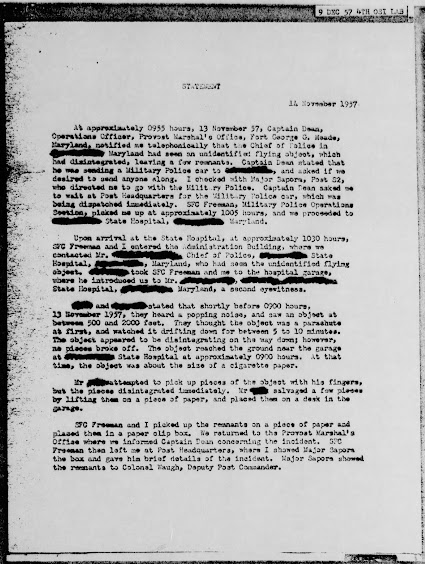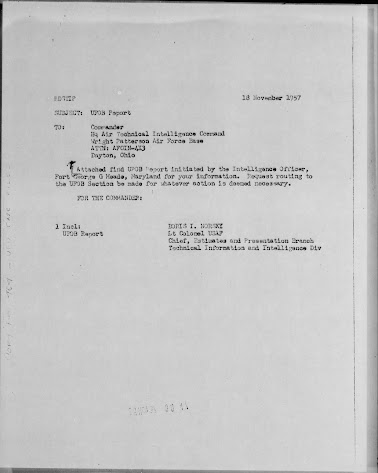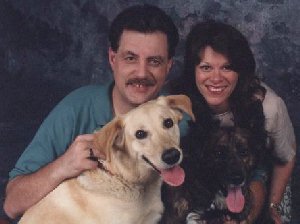There
is now renewed interest in the crash of a UFO near San Antonio, New Mexico, on
August 16, 1945. Notice that this is almost two years before the Roswell crash and
less than a hundred miles from the debris field shown to me by Bill Brazel.
This tale is told by Reme Baca and Jose Padilla, two boys, seven and nine at
the time, who heard the crash and would have been the first humans on the
scene.
 |
| Bill Brazel |
The
story, as originally told, was that the youngsters had been sent in search of a
pregnant cow. The one boy’s father was afraid that if the calf was born out on
the range and they didn’t claim it first, then someone else would find it and
brand it. They had ridden over the high desert, climbed rocky formations,
stopped to have lunch, and then dodged a thunderstorm. As the rain ended and
they came out from under the ledge where they had hidden, there was a bright
light with a rumbling sound that shook the ground.
The
boys headed in the direction of the sound where there seemed to be a cloud of
dust and smoke. They found a “giant-sized gouge” that they said looked like heavy
machinery had created a road about one hundred feet wide, about a foot deep and
maybe three hundred feet long. Through binoculars, Jose could see that the
gouge ran up to a ridge where it stopped. At the far end they could see an
object that had dug deep into the sandy soil.
As
have been found near Roswell two years later, there was a debris field here.
Reme said that he picked up a piece of thin, shiny foil, like that from a pack
of cigarettes. When he folded it or wadded it, it returned to its original
shape.
They
worked their way closer, and through the binoculars, Jose saw three, small,
creatures. They were moving around rapidly, almost as if they could teleport
themselves from one position to another. The motion was described as sliding.
The creatures had a buggy look to them. They had big bulgy eyes, had needle
thin arms and were about four feet tall. The head was big and when pressed, he compared
it to a Praying Mantis. Their skin was a light gray and they were either
wearing very tight coveralls or their skin was very tight.
 |
The New Mexico high Desert.
|
The
craft was shaped something like an avocado, with a hole in the side. They tried
to get an estimate of the size, deciding it was about 100 feet long. There was
a noise coming from the craft. The sound was like that a jack rabbit in trouble
would make or maybe like a baby crying.
As
they watched it, both said that they got “pictures in their heads.” This seemed
to be some sort of telepathic communication. Reme would later say that they
didn’t know that these pictures were. Decades later, he said that he still
didn’t know what the pictures meant.
By
this time, they realized that it was getting late, actually getting dark, and
they had to go home. Once there, they told Jose’s father, Faustino, about what
they had seen and the humanoid creatures that they called Hombrecitos.
Spanish for little men. Faustino said that they would check it out in a day or
two.
Two
days later they returned to the crash site. Not only were they accompanied by
Faustino, but also by a State Policeman, Eddie Apodaca. As the party approached
the crash site, they didn’t see the alien creatures, nor, at first did they see
the craft. It was as if it had disappeared. But then, as they headed down into
the canyon, the object reappeared, “as if by magic.”
It
seemed that most of the debris had been cleaned up by someone. There wasn’t
much of the wreckage left, other than the craft itself. There were odd pieces
dangling all over. The two men told the boys to wait, as they crawled up,
inside, through gash in the side of the object. When they came out, according
to Reme, the men seemed to have changed, different. They were now more serious.
Faustino
warned the boys about telling anyone what they had seen. He said, strangely,
that the government calls these sorts of things, weather balloons. He added, “They’ll
want this thing back.”
Reme
said that it didn’t look like any weather balloon they had seen in the past.
And, he wondered about the little men. He wondered what had happened to them.
Two
days after that second visit to the craft, the recovery operation started in
earnest. A sergeant named Avila, probably Army sergeant, approached those in
the Padilla home. He wanted permission to cut a hole in a fence so that they
could get their heavy equipment to the crash site. They would be removing the
craft and needed to create a better access to the area. An agreement was
reached, a road was built and the gate installed.
The
youngsters, Reme and Jose, continued their surveillance of the crash site, even
after the warning about possible trouble. Now, we learn, based on Reme and Jose’s
observations, that the solders weren’t doing such a great job. Rather than
collecting all the debris, they buried some of it on site. Other debris was
kicked into crevasses and covered over. They watched as a flatbed truck was
brought in. Using winches and a crane, the soldiers lifted the craft onto the
truck. They covered it with a tarp and even though it was not ready for
removal, the soldiers left for the day.
With
the site now abandoned, the boys walked up to take a closer look. Jose untied
the ropes holding the tarp in place and climbed inside the object. He found
something interesting inside the craft and handed it out to Reme. It was very
light and cold to the touch. The boys then left, carrying the bit of debris
with them.
About
two weeks after the recovery operation had been completed and the object
removed, four soldiers arrived at the Padilla house. They were looking for
something more and asked permission to search the premises. They wanted to know
if Faustino had anything that might belong to them, meaning, of course, any
metal or other items taken from the crash site. The soldiers were shown to a back
room where they searched carefully, eventually confiscating a weather balloon
or two and other odds and ends. Yes, apparently, Faustino had found weather
balloons in the past and stored them in his house.
But
the military didn’t manage to grab the bits of debris that the boys had found.
According to Reme, the material was later analyzed but neither the facilities nor
the scientists were identified other than one given the pseudonym of Dr. Smith.
Apparently, the metal had a high concentration of carbon. Samples cut and
polished showed “very weird structures… they look like skeletons of bugs…” You
can see photographs of the metal here:
https://www.coasttocoastam.com/photo/ufo-crash-remnants-ii-photo/
Other
scientists in other labs were consulted who confirmed the first results, which was
that the metal was unusual. They also found that the metal could “transfer heat
from one end to the other…a bit like the tiles o the space shuttle.”
But
that wasn’t the end of the analyses. Further, and more comprehensive results
were published at The Black Vault. The bottom line is that there doesn’t seem
to be anything in the metal that suggests an extraterrestrial origin. It was
noted that the objects are made of aluminum alloyed to copper and silicon.
Isotopic ratios determined for the nickel, copper and zinc compare to
terrestrial value but that does not rule out an extraterrestrial source for the
material. You can view that information, including the request for analysis by
MUFON, names of the scientists and the lab used, here:
https://www.theblackvault.com/casefiles/analysis-two-metallic-parts-purportedly-crashed-unidentified-aerial-object-san-antonio-new-mexico-august-16-1945/
So,
where does that leave us?
Looking
at this with a critical eye, I have some real problems. First, are the young
ages of the witnesses at the time of the event. True, I can see kids trying to
get closer and trying to discover what had happened, but the time line doesn’t
seem to work out very well. In the interviews, time seems to flow rapidly and
then slow down, only to speed up again. Is this a minor criticism? Sure, but it
is not the only problem.
I
was bothered by the description of the metal as being very thin aluminum, like
that found on a pack of cigarettes. This was the description used by Jesse
Marcel, Sr. talking about some of the debris he had seen on the Debris Field
near Corona in 1947. This information was published long before either of the
boys (now men) told their story to outsiders.
Later
on, they talked about a metal that could be wadded up and that would return to
its original shape. Reme said, “…so I pulled it out from under the rock and
kind of rolled it up and folded it up… and it would go back into the same
position that it was. So, I took that and put it I my pocket…”
Robert
Smith, who had been assigned to Roswell in July, 1947, said one of the
sergeants had taken a bit of debris. He told Don Schmitt and me, “It was just a
little piece of metal or foil or whatever it was. Just small enough to be
slipped in a pocket.”
Bill
Brazel said, “The only reason I noticed the tin foil was that I picked the
stuff up and put it in my chaps’ pocket… when I put the piece of foil in the
box it started unfolding and flattened out.” Again, this information had been
well reported before with Reme or Jose mentioned it.
It
is also interesting that the boys talk about four military members coming out
to the house to search for anything unusual. Bill Brazel talked about four
soldiers going out to his house and confiscating the debris he had picked up.
Of course, here they failed to find anything but Bill Brazel surrendered what
he had found.
These
points can be viewed two ways. One is that here was independent corroboration
for the types of material found in Roswell. The other is that the boys, when
interviewed decades later, had heard about the material found in Roswell and used
those descriptions. It is clear in the interviews that they had been reading
about UFOs and crash retrievals, based on their answer to some of the questions
and their discussions with researchers.
One
of the other problems I have is the fairly cavalier way the military treated
the crash site. Although there are hints that they had secured the area, they
seemed to leave it unguarded at times. No matter what had fallen, if the
military had thought it important enough that they would build a road to the
site, and put in a proper gate so that they could bring in a flatbed truck,
then it was important enough to guard properly. That would mean soldiers out
there twenty-four hours a day until the site was cleaned. However, according to
the witnesses, that simply wasn’t the case.
The
other aspect is the failure to properly clean the site. Apparently, they did
send out soldiers to pick up the debris, but sometimes, the soldiers just
kicked the material into a crevasse and buried it. There doesn’t seem to be any
officers out there, and once again, given the nature of the material, and the
craft that supposedly crashed, there would have been a real effort to clean up
everything. They would want nothing left behind.
The
final problem is the boys being told about weather balloons. Since this was
1945, two years before the Roswell case was “identified” as a weather balloon,
this reference is anachronistic. It is out of place because no one was talking about
weather balloons being used to explain UFO sightings. This is a major problem.
On
a more positive side, a fellow named Bill Brophy said that his father had been
a member of the 231st B-29 bomber group (actually the 231st
Army Air Force Base Unit) at Alamogordo, New Mexico. According to Brophy, the
231st was part of the recovery operation in August 1945. I was able
to confirm that the 231st was stationed at Alamogordo Army Air Field
and had B-29s at the time claimed. This might be a third witness to the crash
and does provide a clue about where to look for additional information.
In
the end, I’m skeptical about this story. There are too many little things that
bother me about it, from the descriptions of the material that match those from
Roswell, the knowledge the two witnesses have of UFOs, including talking about
books such as The Day After Roswell, and the lack of proper military
security. Even if the officers didn’t recognize the craft as being
extraterrestrial, they would have seen it as an aircraft of unique design that
would require proper security.
For
an even more skeptical point of view, you might want to visit Jason Colavito’s
website at:
https://www.jasoncolavito.com/blog/new-book-from-jacques-vallee-claims-evidence-for-1945-new-mexico-ufo-crash
However,
there is a book coming out in a month or so that might adequately answer these
questions. This is my analysis of the situation now and I look forward to
seeing what additional information surfaces.


















































